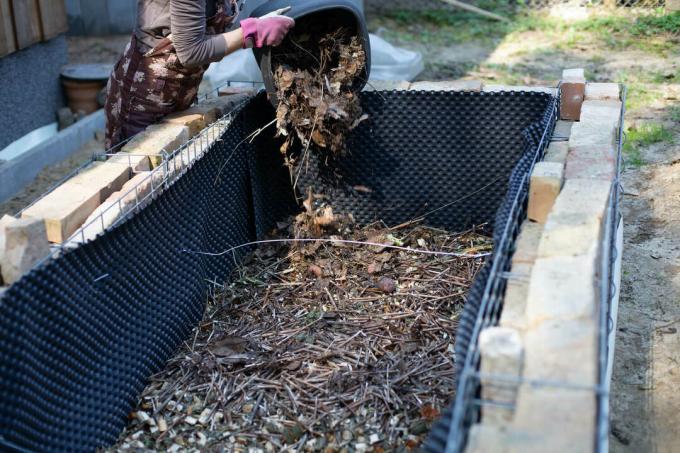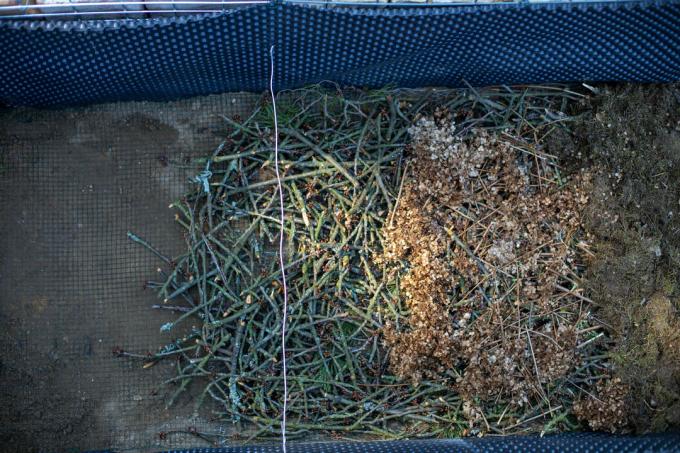The correct filling of a raised bed is essential for healthy plants and a rich harvest. We explain which layers belong in a raised bed and what purpose they serve.

After this Construction of a raised bed Filling is the last step before sowing and planting. A system made up of different layers has proven its worth. In this article you will learn everything about building a raised bed, about the individual layers and their functions.
contents
- Why should a raised bed be layered?
- What layers does a raised bed have?
- Can you only fill raised beds with soil?
- Layer low raised beds
Why should a raised bed be layered?
The layer structure of the raised bed filling basically mimics the natural processes in the formation of humus. From top to bottom, the materials become coarser, larger and more difficult to decompose. For years there is therefore a food supply for soil organisms which, through their tireless work, expose nutrients for the plants in the raised bed. This is particularly important because the raised bed is largely cut off from the outside world. The layering in the raised bed also regulates temperature, ventilation and water balance. It is used for drainage and at the same time stores water, which is particularly advantageous in summer.
How often do you have to refill a raised bed? In the first year, the soil in the raised bed can sag significantly, but the difference in height can initially be easily filled with high-quality potting soil. Over the years the layers decompose and after about six to seven years the raised bed should therefore be emptied and piled up again. The one that emerged from the previous lowest layers humus can basically be distributed anywhere in the garden.

What layers does a raised bed have?
The layers of a raised bed mimic the decomposition process from bottom to top. Each layer should be 10 to 25 cm high, depending on the height of the raised bed. Traditionally, branches, root wood and smaller tree trunks are layered in various thicknesses at the bottom of the raised bed. In order to further improve the water drainage, you can occasionally build in larger stones. The bottom layer of the raised bed is followed by a filling or base layer, which consists of chopped up wood, leaves, and cuttings from plants and lawns. This material has a wide attack surface for decomposing microorganisms, so that it is decomposed much faster than the coarse branches of the lowest layer.
This is followed by a layer of well-ripened compost, from which numerous soil organisms feed and deliver nutrients to the top. Our Plantura organic compost improves humus formation, promotes soil life and is ideal for filling raised beds as a compost layer. It is completely peat-free and is clearly CO2-reduced made in Germany. The last and top layer in the raised bed is a level of potting soil. But which soil should you use for a raised bed? The following applies here: A high-quality, nutrient-rich potting soil is the best choice in the raised bed, as it is suitable for most types of vegetables and herbs. Our peat-free Plantura organic tomato and vegetable soil has all these qualities and comes to you in sustainable packaging via climate-neutral shipping.
At a glance: how do you layer a raised bed?
- Lower layer: thick branches, tree trunks and stones.
- Filling layer: Loose, shredded plant material such as plant and lawn clippings, leaves or wood chips.
- Compost layer.
- Planting layer: nutrient-rich potting soil with a fine-crumbly structure.
Can you only fill raised beds with soil?
The layered structure of the raised bed is advantageous, but of course optional, because the bed can only be filled with pure potting soil. This saves work and can be achieved with just a few materials. In the first year there will usually be no difference to layered raised beds. However, the water storage is usually worse, so that it has to be watered more often. The big disadvantage is that many of the nutrients it contains completely disappear after a few years are used up, as no replenishment is carried up by the decomposition of the lower layers will. Soil life also finds hardly any nourishment in pure potting soil, which in the long term reduces fertility. The result is often that you have to fertilize a lot and more often so that the plants on the raised bed do not suffer from nutrient deficiencies and do not grow poorly.

Layer low raised beds
Raised beds, especially in the city garden on the balcony and terrace, are sometimes very low, so that there is hardly any space for all four layers. Here you can reduce to the essentials: At the very bottom a layer of stones, leaves and wood chips that promote water drainage and ventilation. Above that you fill in the compost layer, from which nutrients are converted. Finally, there is a layer of potting soil in which the cultures take root. The smaller the raised bed, the narrower the lower layers will be. The top layer of plants should always be at least 10 cm, better still 15 to 20 cm high, to provide enough space for the roots.
Once all the layers have been poured in, it's time for you Planting the raised bed. In our article we have put together useful tips and plant combinations for a bountiful harvest and for pest control.



